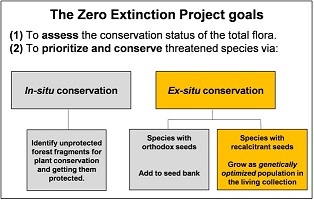Xishuangbanna (Yunnan province) is a plant diversity hotspot, supporting more than 10% of China’s angiosperm flora in less than 0.2% of its land area. Agricultural expansion in recent decades had resulted in habitat loss and fragmentation, threatening the survival of many plant species. To ensure the long-term survival of threatened species, the Xishuangbanna Tropical Botanical Garden (XTBG) initiated the “Zero Extinction Project” in 2012. The project aims to reduce the extinction rate of native flora in the prefecture to zero and is part of XTBG’s commitment to the Global Strategy for Plant Conservation (GSPC) 2011-2020. Central to this project is the ex situ conservation of threatened species, many of which will be included in the living collection within XTBG.

To maximize the conservation value of ex situ plant populations, XTBG recently undertook a venture to genetically optimize its living collection, i.e. to ensure that the total genetic diversity of wild populations is captured by the least number of individuals in the collection. The garden aims to leverage on the capacity of next generation sequencing technologies to deliver a genotyping method that is (1) rapid, (2) applicable to many angiosperm species, (3) sufficiently cost-effective to screen large numbers of seedlings, and (4) easily transferable to other botanical gardens. Currently, the pilot study for genetic optimization is underway, focusing on Aglaia teysmanniana, a species with a near threatened (NT) status on the IUCN Red List that can be found in limestone forests in Xishuangbanna.
Genetic optimization of the living collection has far-reaching implications: besides enabling the garden to extensively increase the capacity of its living collection without a substantial investment in space, it also ensures that the evolutionary potential of the ex situ populations is not compromised. Genetic optimization is a common practise in captive breeding of animals, but is yet to be widely applied in plant conservation. Therefore, this project represents a large technological step forward in the ex situ conservation of tropical plant species and is essential to the realization of Target 8 in the GSPC. Currently, the “Zero Extinction Project” initiated by XTBG has been replicated by other botanical gardens in the Chinese Union of Botanical Gardens (CUBG). Therefore, the methodology developed in this study could potentially be adopted by Chinese botanical gardens in the near future.
As XTBG’s genetic optimization is still in its initial phase, the lead researcher of this project is seeking to discuss the following conceptual/technical challenges of ex situ conservation in plants with researchers/botanists worldwide:
1. Lack of consensus on the selection criteria for the genetically optimized population. Should the selection be based on genetic relatedness, rare alleles or genetic structure?
2. Lack of technical guidelines on the management of the genetically optimized population. Should outbreeding depression be of concern?
3. Lack of long-term efforts to reintroduce threatened species back into the wild. For how many generations should the population remain in the living collection?
URL: http://www.bgci.org/resources/news/1202/

